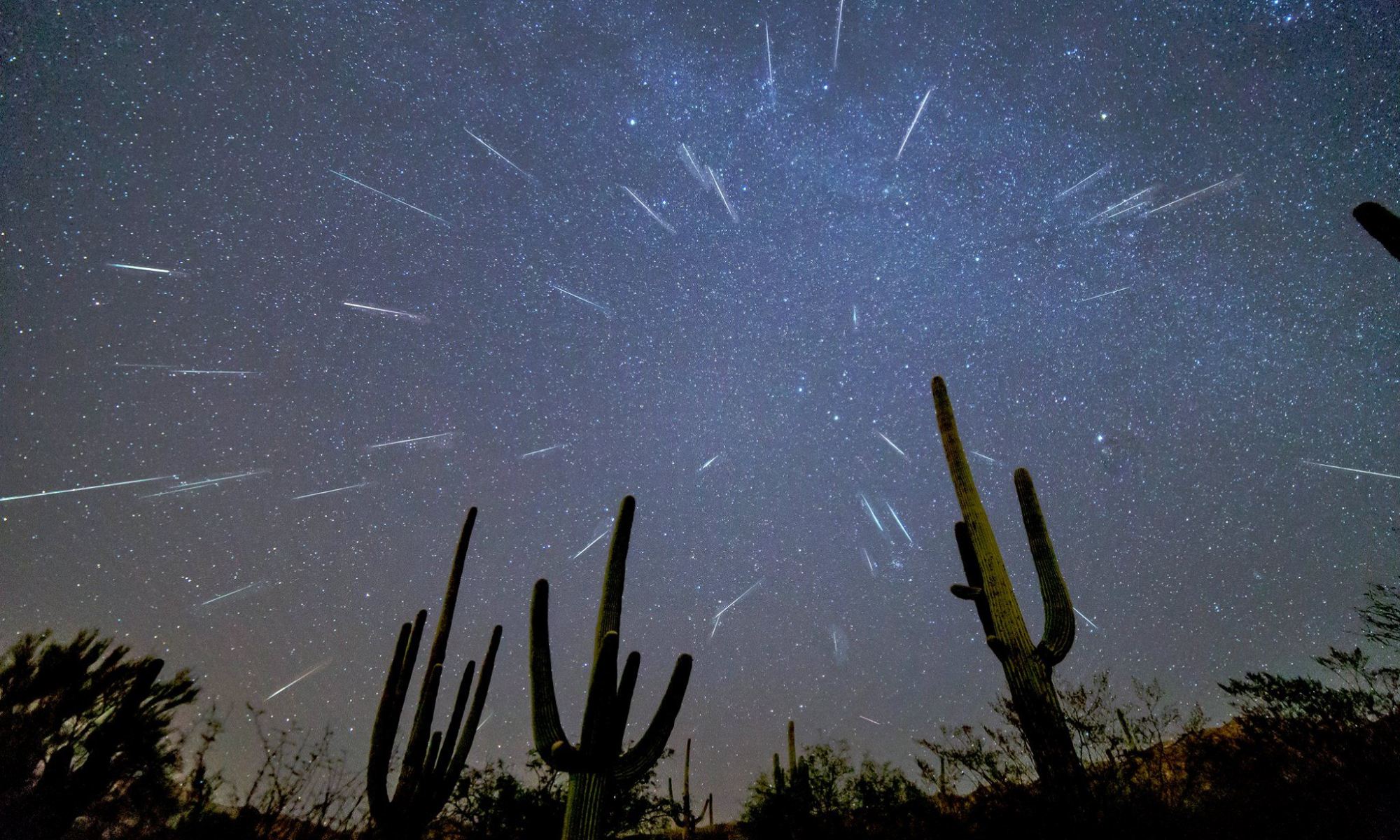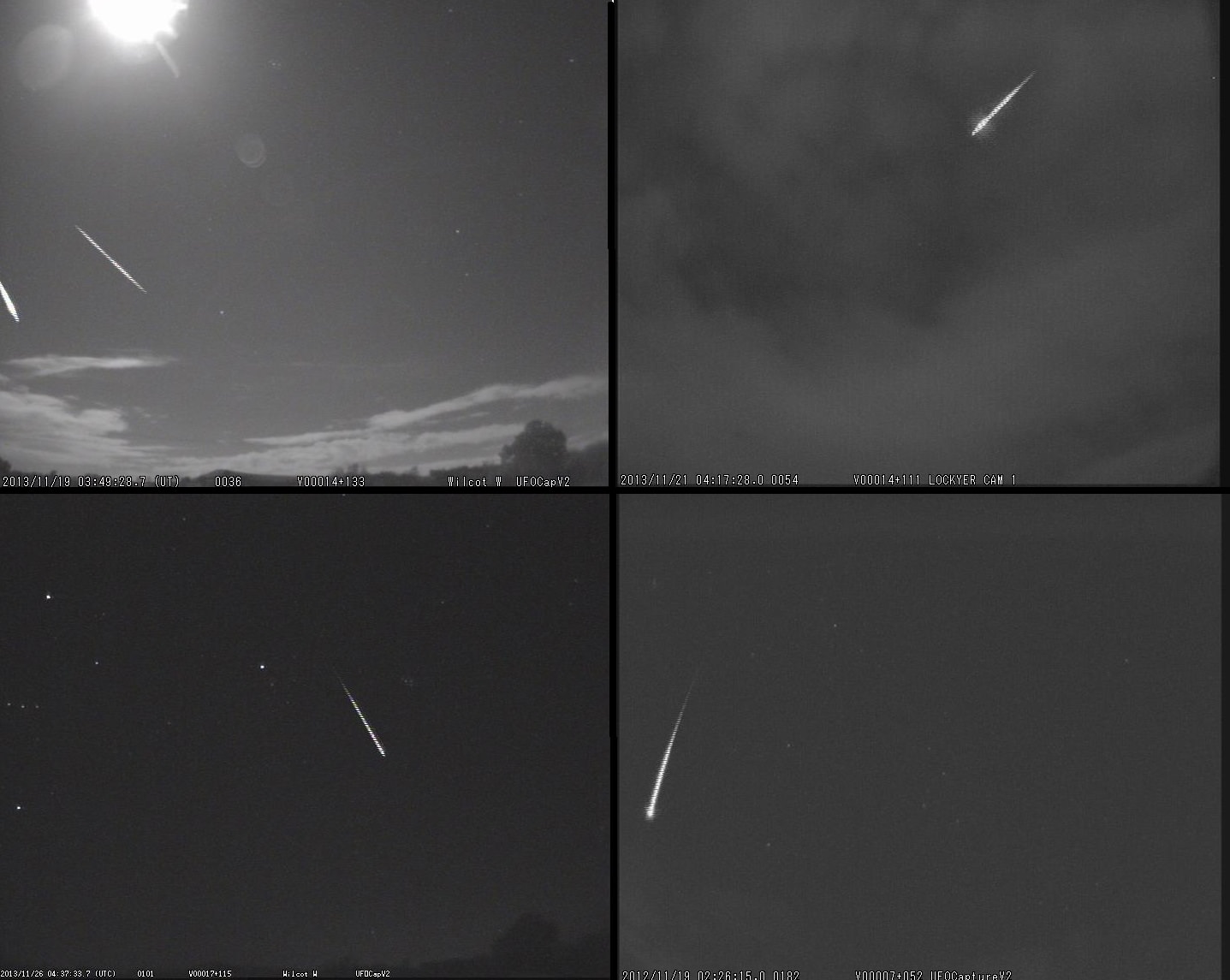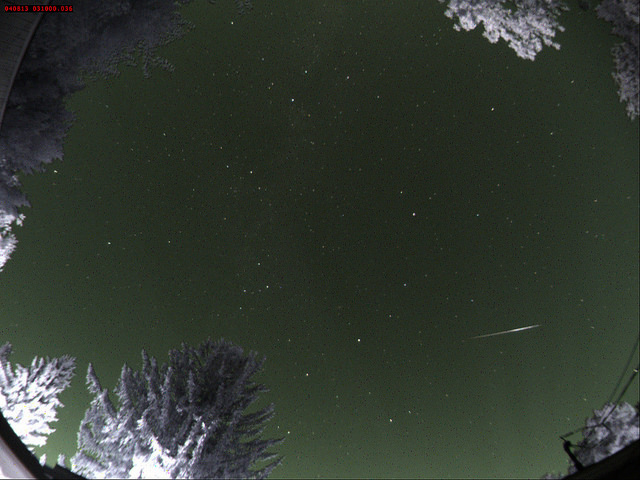Got clear skies? Then be sure to bundle up: the Geminid meteors—one of the best, sure-fire annual meteor showers—peaks this weekend… and near a New Moon, to boot.
Continue reading “Why 2020 is a Great Year for the Geminid Meteors”Midway Between Storms: Our Guide to the 2014 Leonid Meteors
If there’s one meteor shower that has the potential to bring on a storm of epic proportions, it’s the Leonids. Peaking once every 33 years, these fast movers hail from the Comet 55P Temple-Tuttle, and radiate from the Sickle, or backwards “question mark” asterism in the constellation Leo. And although 2014 is an “off year” in terms of storm prospects, it’s always worth taking heed these chilly November mornings as we await the lion’s roar once again.
The prospects: 2014 sees the expected peak of the Leonids arriving around 22:00 Universal Time (UT) which is 5:00 PM EST. Locally speaking, a majority of meteor showers tend to peak in the early AM hours past midnight, as the observer’s location turns forward facing into the oncoming meteor stream. Think of driving in an early November snowstorm, with the car being the Earth and the flakes of snow as the oncoming meteors. And if you’ve (been fortunate enough?) to have never seen snow, remember that it’s the front windshield of the car going down the highway that catches all of the bugs!
This all means that in 2014, the Asian Far East will have an optimal viewing situation for the Leonids, though observers worldwide should still be vigilant. Of course, meteor showers never read online prognostications such as these, and often tend to arrive early or late. The Leonids also have a broad range of activity spanning November 6th through November 30th.

The predicted ideal Zenithal Hourly Rate for 2014 stands at about 15, which is well above the typical background sporadic rate, but lower than most years. Expect the actual sky position of the radiant and light pollution to lower this hourly number significantly. And speaking of light pollution, the Moon is a 21% illuminated waning crescent on the morning of November 17th, rising at around 2:00 AM local in the adjacent constellation of Virgo.
The Leonids can, once every 33 years, produce a storm of magnificent proportions. The history of Leonid observation may even extend back as far as 902 A.D., which was recorded in Arab annals as the “Year of the Stars.”
But it was the morning of November 13th, 1833 that really gained notoriety for the Leonids, and really kicked the study of meteor showers into high gear.
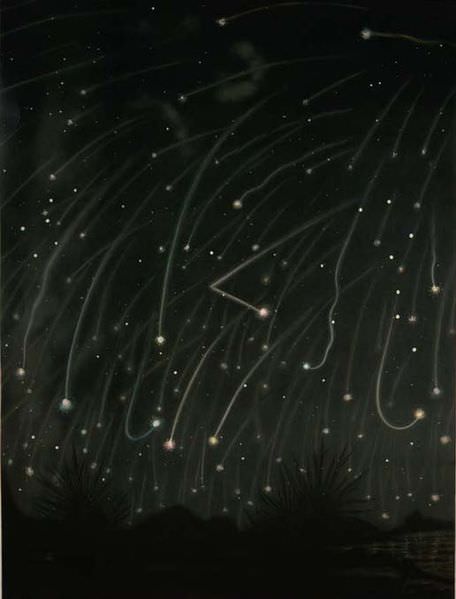
The night was clear over the U.S. Eastern Seaboard, and frightened townsfolk were awakened to moving shadows on bedroom walls. Fire was the first thing on most people’s minds, but they were instead confronted with a stunning and terrifying sight: a sky seeming to rain stars in every direction. Churches quickly filled up, as folks reckoned the Day of Judgment had come. The 1833 Leonid storm actually made later historical lists as one of the 100 great events in the United States for the 19th century. The storm has also been cited as single-handedly contributing to the religious fundamentalist revivals of the 1830s. Poet Walt Whitman witnessed the 1833 storm, and the song The Stars Fell on Alabama by Frank Perkins was inspired by the event as well.
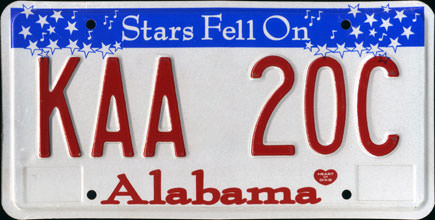
But not all were fearful. Astronomer Denison Olmsted was inspired to study the radiants and paths of meteor streams after the 1833 storm, and founded modern meteor science. The Leonids continued to produce storms at 33 year intervals, and there are still many observers that recall the spectacle that the Leonids produced over the southwestern U.S. back 1966, with a zenithal hourly rate topping an estimated 144,000 per hour!
We also have a personal fondness for this shower, as we were fortunate enough to witness the Leonids from the dark desert skies of Kuwait back in 1998. We estimated the shower approached a ZHR of about 900 towards sunrise, as a fireballs seemed to light up the desert once every few seconds.

The Leonids have subsided in recent years, and have fallen back below enhanced rates since 2002. Here’s the most recent ZHR levels as per the International Meteor Organization:
2009: ZHR=80.
2010: ZHR=32.
2011: ZHR=22.
2012: ZHR=48.
Note: 2013 the shower was, for the most part, washed out by the Full Moon.
But this year is also special for another reason.
Note that the 2014-2015 season marks the approximate halfway mark to an expected Leonid outburst around 2032. Comet 55P Tempel-Tuttle reaches perihelion on May 20th, 2031, and if activity in the late 1990s was any indication, we expect the Leonids to start picking up again around 2030 onward.

Observing meteors is as simple as laying back and looking up. Be sure to stay warm, and trace the trail of any suspect meteor back to the Sickle to identify it as a Leonid. The Leonid meteors have one of the fastest approach velocities of any meteor stream at 71 kilometres per second, making for quick, fleeting passages in the pre-dawn sky. Brighter bolides may leave lingering smoke trails, and we like to keep a set of binoculars handy to examine these on occasion.
Looking to do some real science? You can document how many meteors you see per hour from your location and send this in to the International Meteor Organization, which tabulates and uses these volunteer counts to characterize a given meteor stream.
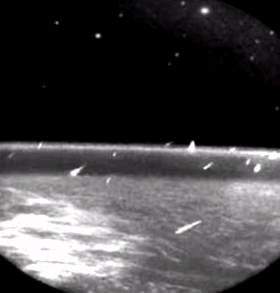
And taking images of Leonid meteors is as simple as setting your DSLR camera on a tripod and taking long exposure images of the night sky. Be sure to use the widest field of view possible, and aim the camera about 45 degrees away from the radiant to nab meteors in profile. We generally shoot 30 second to 3 minute exposures in series, and don’t be afraid to experiment with manual F-stop/ISO combinations to get the settings just right for the local sky conditions. And be sure to carefully review those shots on the “big screen” afterwards… nearly every meteor we’ve caught in an image has turned up this way.
Don’t miss the 2014 Leonids. Hey, we’re half way to the start of the 2030 “storm years!”
When Good Meteor Showers Go Bad: Prospects for the 2014 Perseids
It’s that time of year again, when the most famous of all meteor showers puts on its best display.
Why are the Perseids such an all ‘round favorite of sky watchers? Well, while it’s true that other annual meteor showers such as the Quadrantids and Geminids can exceed the Perseids in maximum output, the Perseids do have a few key things going for them. First, the shower happens in mid-August, which finds many northern hemisphere residents camping out under warm, dark skies prior to the start of the new school year. And second, unlike showers such as the elusive Quads which peak over just a few hours, the Perseids enjoy a broad span of enhanced activity, often covering a week or more.
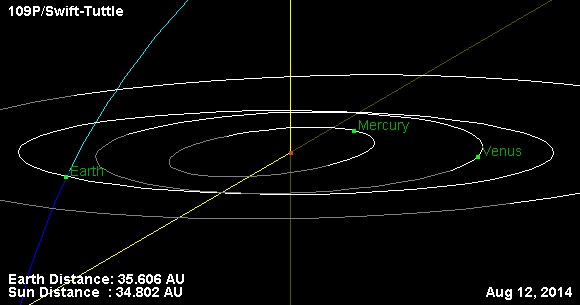
These are all good reasons to start watching for Perseids now. Here’s the low down on the Perseid meteors for 2014:
The History: The Perseids are sometimes referred to as “The Tears of Saint Lawrence,” who was martyred right around the same date on August 10th, 258 A.D. The source of the shower is comet 109P Swift-Tuttle, which was first identified as such by Schiaparelli in 1866. The comet itself visited the inner solar system again recently in 1992 on its 120 year orbit about the Sun, and rates were enhanced throughout the 1990s.
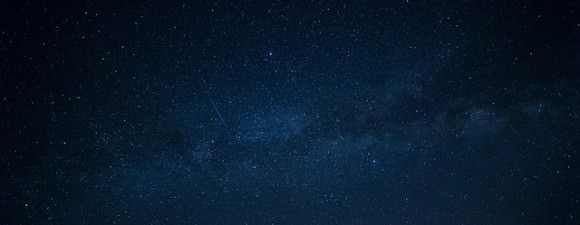
Unlike most showers, the Perseids have a very broad peak, and observers and automated networks such as UKMON and NASA’s All Sky Camera sites have already begun to catch activity starting in late July.
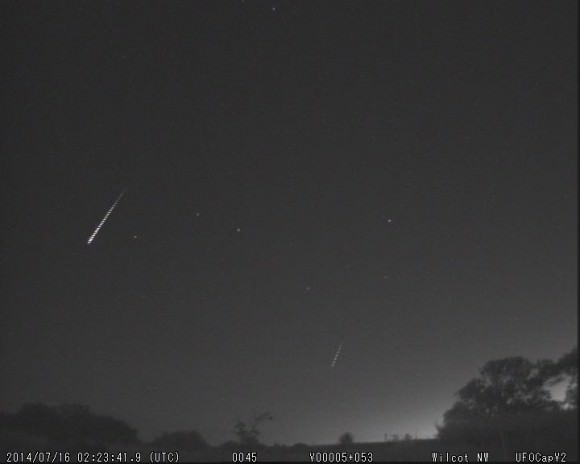
In recent years, the rates for the Perseids have been lowering a bit but are still enhanced, with ZHRs at 91(2010), 58(2011), 122(2012), and 109(2013). It’s also worth noting that the Perseids typically exhibit a twin peak maximum within a 24 hour span. The International Meteor Organization maintains an excellent page for quick look data to check out what observers worldwide are currently seeing. The IMO also encourages observers worldwide to submit meteor counts by location. Note that the phase of the Moon was near Full in 2011, with observing circumstances very similar to 2014.
The Prospects for 2014: Unfortunately, the 2014 Perseid meteors have a major strike going against them this year: the Moon will be at waning gibbous during its peak and just two days past Full illumination. This will make for short exposure times and light polluted skies. There are, however, some observational strategies that you can use to combat this: one is to place a large building or hill between yourself and the Moon while you observe — another is to start your morning vigil a few days early, before the Moon reaches Full. The expected Zenithal Hourly Rate for 2014 is predicted to hover around 90 and arrive around 00:15 to 2:00 UT on August 13th favoring Europe, Africa and the Middle East.
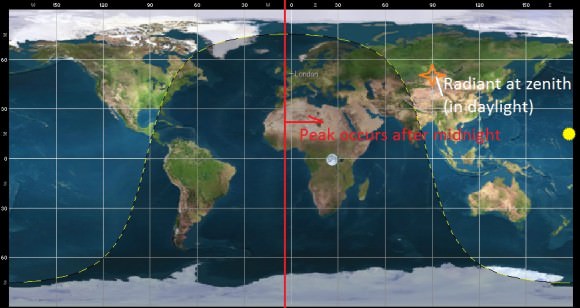
The Radiant: It’s strange but true: meteor shower radiants wander slightly across the sky during weeks surrounding peak activity, due mostly to the motion of the Earth around the Sun. Because of this, the radiant of the Perseids is not actually in the constellation Perseus on the date that it peaks! At its maximum, the radiant actually sits juuusst north of the constellation that it’s named for on the border of Camelopardalis and Cassiopeia. This is a great pedantic point to bring up with your friends on your August meteor vigil… they’ll sure be glad that you pointed this out to ’em and hopefully, invite you back for next year’s Perseid watch.
The actual position of the radiant sits at 3 Hours 04’ Right Ascension and +58 degrees north declination.
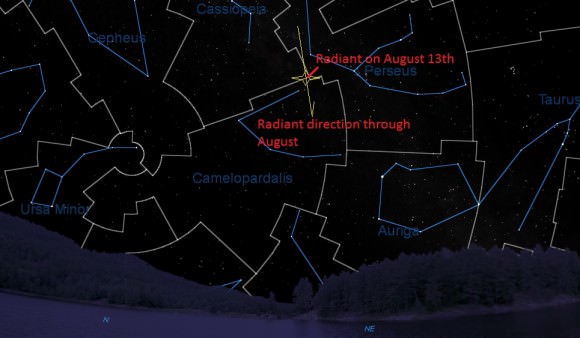
Meteor-speak: Don’t know your antihelion from a zenithal hourly rate? We wrote a whole glossary that’ll have you talking meteors like a pro for Adrian West’s outstanding Meteorwatch site a few years back. Just remember, the crucial “ZHR” of a shower that is often quoted is an ideal extrapolated rate… light pollution, the true position of the radiant, observer fatigue and limited field of view all conspire to cause you to see less than this predicted maximum. The universe and its meteor showers are indeed a harsh mistress!
Observing: But don’t let this put you off. As Wayne Gretsky said, “You miss 100% of the shots that you don’t take,” and the same is true with meteor observing: you’re sure to see exactly zero if you don’t observe at all. Some of my most memorable fireball sightings over the years have been Perseids. And remember, the best time to watch for meteors is after local midnight, as the Earth is turned forward into the meteor stream. Remember, the car windshield (Earth) gets the bugs (meteors) moving down the summer highway…
Good luck, and let us know of those tales of Perseid hunting and send those meteor pics in to Universe Today!
Get Ready for the Lyrid Meteor Shower: Our Complete Guide for 2014
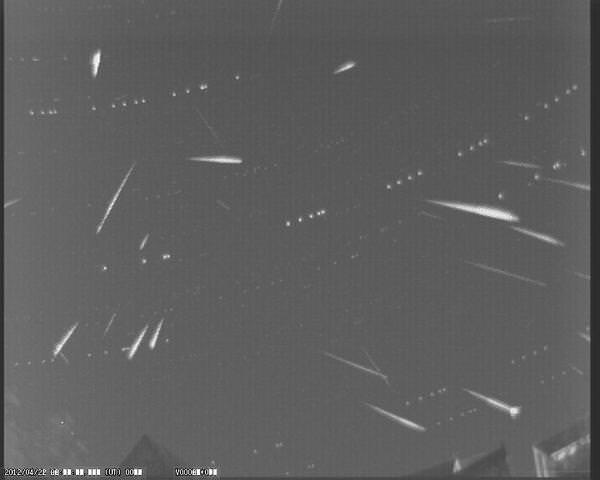
The month of April doesn’t only see showers that bring May flowers: it also brings the first dependable meteor shower of the season. We’re talking about the Lyrid meteors, and although 2014 finds the circumstances for this meteor shower as less than favorable, there’s still good reason to get out this weekend and early next week to watch for this reliable shower.
The Lyrid meteor shower typically produces a maximum rate of 10-20 meteors per hour, although outbursts topping over a hundred per hour have been observed on occasion. The radiant, or the direction that the meteors seem to originate from, lies at right ascension 18 hours and 8 minutes and declination +32.9 degrees north. This is just about eight degrees to the southwest of the bright star Vega, which is the brightest star in the constellation of Lyra the Lyre, which also gives the Lyrids its name.
Fun fact: this radiant actually lies juuusst across the border of Lyra in the constellation of Hercules… technically, the “Lyrids” should be the “Herculids!” This is because the shower was identified and named in the 19th century before the International Astronomical Union officially adopted the modern layout we use for the constellations in 1922.
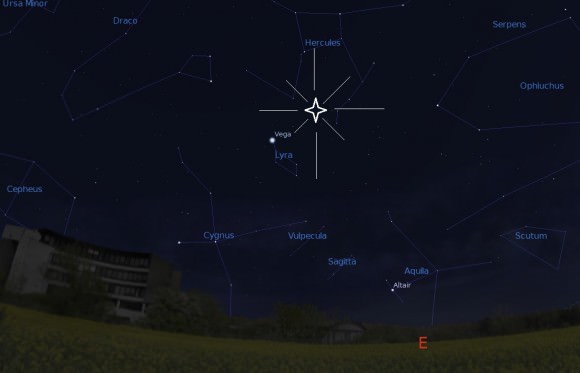
The source of the Lyrids was tracked down in the late 1860s by mathematician Johann Gottfried Galle to Comet C/1861 G1 Thatcher, the path of which came within 0.02 Astronomical Units (A.U.s) of the Earth’s orbit on April 20th, 1861, just six weeks before the comet reached perihelion. Comet G1 Thatcher is on a 415 year orbit and won’t return to the inner solar system until the late 23rd century.
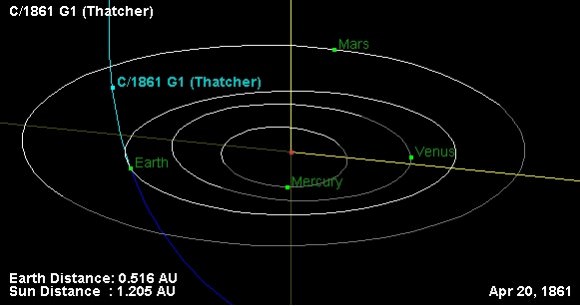
But we can enjoy the dust grains it left in its wake as they greet the Earth to burn up in its atmosphere every April. The activity of the Lyrids typically spans April 16th to the 25th, with a short 24 hour peak above a ZHR of 10 on April 22nd-23rd. Thus, like the short duration Quadrantids in January, timing is critical; if you happen to observe this shower before or after the peak, you may see nothing at all. This year, the key mornings will be Tuesday, April 22nd, and Wednesday April 23rd. The wide disparity of predictions for the exact arrival of the peak of the Lyrids, as quoted in differing sources speaks to just how poorly this meteor shower is understood. Scanning various reliable resources, we see times quoted from April 22nd at 4:00 Universal Time (UT) from the American Meteor Society, to 17:00 UT on the same date for the Royal Canadian Astronomical Society, to April 23rd at 17:45 UT from Guy Ottewell’s venerable 2014 Astronomical Calendar!
Definitely, more observations of this curious shower are needed.
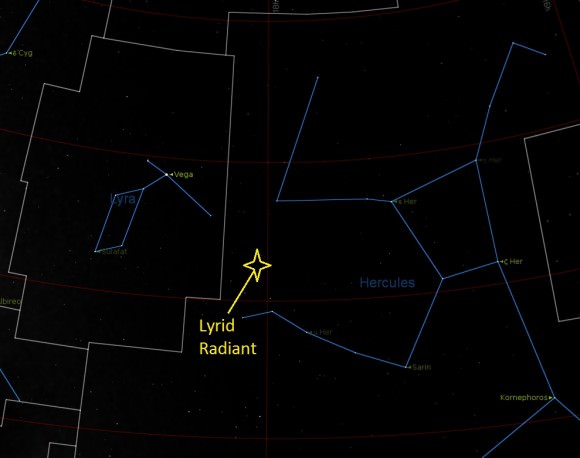
Now for the bad news. This year finds the light-polluting Moon in nearly its worst location possible for a meteor shower. Remember this week’s total lunar eclipse? Well, the Moon is now waning gibbous and will reach last quarter phase at 7:52 UT/3:52 AM EDT on April 22nd, and will thus be rising at local midnight and be high in the sky towards dawn. The Lyrid radiant rises at 9:00 PM this week for observers around 40 degrees north and rides highest at 6:00 AM local, about 45 minutes before sunrise.
Looking at the International Meteor Organization’s historical data, here’s what the Lyrids have done over the past few years:
2013- ZHR 22, Moon phase= 88% illuminated, waxing gibbous.
2012– ZHR 25, Moon phase= 2% illuminated, waxing crescent.
2011- ZHR 20, Moon phase= 73% illuminated waning gibbous.
2010- ZHR 32, Moon phase= 62% illuminated waxing gibbous.
2009- ZHR 15, Moon phase= 7% illuminated waning crescent.
A “ZHR” is the Zenithal Hourly Rate, a theoretical maximum number of meteors that an observer could expect to witness under dark skies if the radiant was straight overhead. Note that 2011 had similar circumstances with respect to the Moon as this year, so don’t despair! The Lyrids are approaching the Earth from nearly perpendicular in its orbit and have a head on velocity of about 48 kilometres per second, respectable for a meteor shower. They also present a higher-than-average number of fireballs, with about a quarter leaving persistent trains.
Outbursts have also occurred in 1803, 1849, 1850, 1922, 1945 and 1982. United States observers based in Florida and Colorado noted a brief ZHR approaching 100 per hour back in 1982 under especially favorable New Moon conditions.
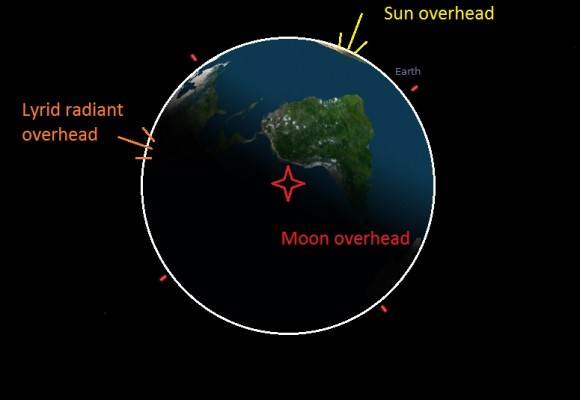
Ironically, the Lyrids are also one of the oldest meteor showers identified from historic records. In fact, Galle actually traced the shower back to Chinese records dating all the way back to March 16th 687 BC, which describes “Stars (that) dropped down like rain…” clearly, the Lyrids were considerably more active in ancient times.
More recently, attempts were made to link the 2012 Sutter’s Mill meteorite fall to the Lyrids, which were underway at the time. This turned out to be a case of “meteor-wrong,” however, as described by Geoff Notkin of the Meteorite Men who noted that no meteorite fall has ever been linked to a meteor shower, though he does get lots of calls whenever news of a big meteor shower hits the press.
A good strategy for beating the Moon includes blocking it behind a hill or building while observing. Early morning is the best time to watch for Lyrids — or most any meteor shower for that matter — as you’re then on the half of the Earth facing forward into the meteor stream. And you don’t have to face toward the radiant to see Lyrid meteors, as they can appear anywhere in the sky.
With the advent of DSLRs, photographing meteors is easier than ever before. All you need to do is use a wide angle lens and take periodic time exposures of the sky. Do a few early test shots to get the combination of f-stop, ISO and shutter speed just right for current sky conditions, and be sure to review those images on a full size monitor afterward: nearly every meteor we’ve captured turned up in post-review only.
Looking to contribute to our understanding of the Lyrid meteors? Simply count the number you see and the location and length of your observation and send your report into the International Meteor Organization. And don’t forget to tweet those Lyrids to #Meteorwatch!
…and there’s more to come. Next month, a true “wildcard outburst” may be in the offing from Comet 209P/LINEAR on May 26th… can you say “Camelopardalids?”
Stay tuned!
Get Ready for the 2013 Geminid Meteor Shower
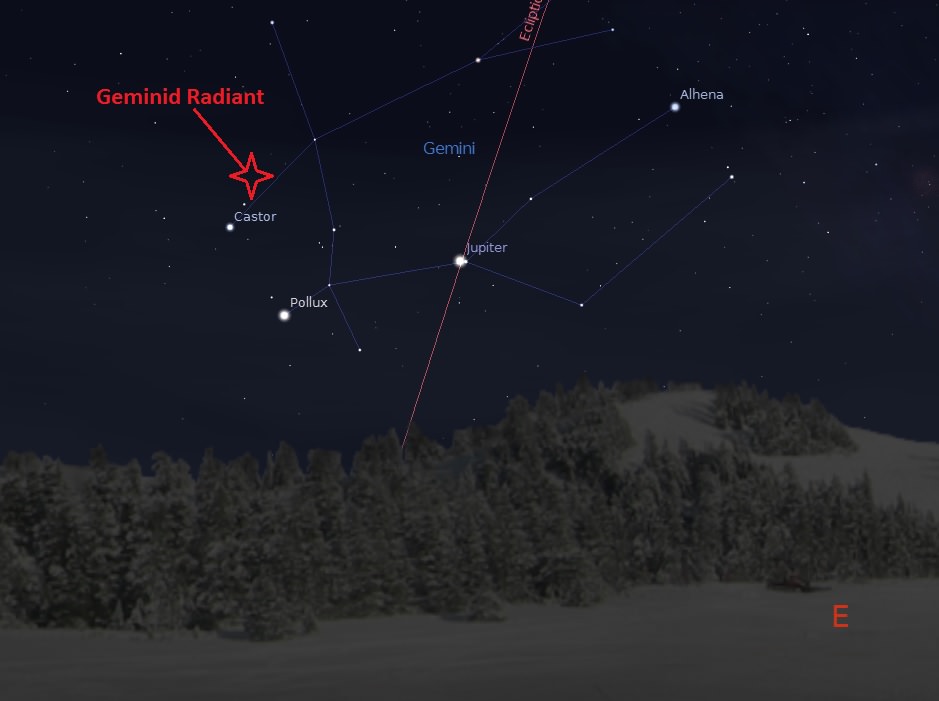
One of the best annual meteor showers occurs this coming weekend.
The 2013 Geminid meteors peak this coming Saturday on December 14th. This shower has a broad maximum, assuring that observers worldwide get a good look. In 2013, the maximum for the Geminids is forecast to span from 13:00 Universal Time (UT) on Friday, December 13th to 10:00UT/5:00AM EST on Saturday, December 14th, with a projected maximum centered a few hours earlier at 2:00 UT Saturday morning.
This is good news for observers spanning both sides of the Atlantic, who should be well placed to catch the event. Keep in mind, meteor showers often peak hours before or after predictions… we certainly don’t know everything that a given meteor stream might have in store!
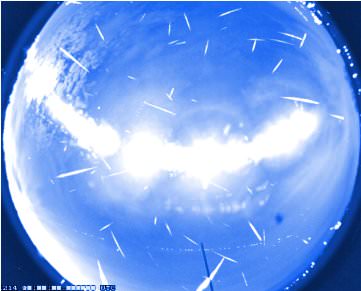
But the time to start watching is now. We’ve already seen a few early Geminids this past weekend, and this shower is notable for showing early activity for northern hemisphere observers before local midnight. This is because the radiant, or the direction that the meteors seem to emanate from lies at a high northern declination of 33 degrees north near the star Castor, also known as Alpha Geminorum.
The typical Zenithal Hourly Rate for the Geminids is 80-120, or about 1 to 2 per minute. Keep in mind, the ZHR is an ideal rate, assuming dark skies, with the radiant positioned directly overhead. Most observers will see significantly less activity.
The 2013 Geminids also have to contend with the waxing gibbous Moon, which reaches Full just 3 days after the shower’s expected maximum. This will give observers a dwindling window between moonset and the start of dawn twilight to catch the Geminids at their best.
We always thought that the Geminids had a bit of an undeserved PR problem among annual showers. This no doubt stems from the fact that they arrive in the chilly month of December, a time when fingers go numb, camera batteries die, and conducting a vigil for meteors is challenging.
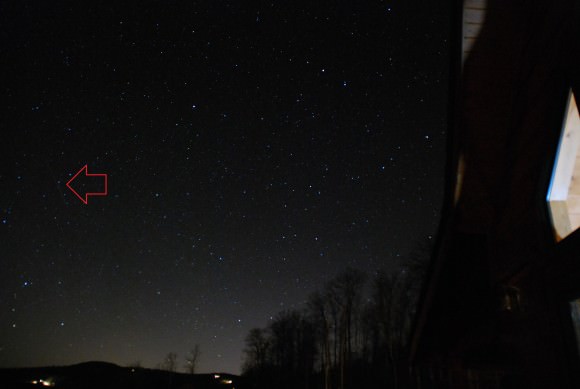
This shower is an interesting one though, with an equally interesting history and source. The Geminids were first identified as a distinct meteor shower by R.P. Greg of Manchester UK in 1862, and the estimated ZHR rose from about 20 to 80 through the 20th century. The parent source of the Geminids remained unknown until 1983, when astronomer Fred Whipple linked them to the strange “rock-comet” body 3200 Phaethon. An Apollo asteroid also thought to be a member of the Pallas family of asteroids, 3200 Phaethon seems to be shedding enough material to produce the annual Geminid meteor shower. This makes the annual shower rare as one not produced by a comet. It’s worth noting that 3200 Phaethon also passes extremely close – 0.14 AU – from the Sun at perihelion, and gets periodically “baked” during each 1.4 year passage.
In the 21st century, rates for the Geminids have stayed above a ZHR of 120, currently the highest of any annual shower. It’s worth noting that an extrapolated ZHR of almost 200 were seen in 2011 when the Moon was at an equally unfavorable waning gibbous phase! The Geminids always produce lots of fireballs, capable of being seen even under moonlit skies.
There are also two other showers currently active to watch for this week. One is the Ursid meteors, which radiate from the Little Dipper (Ursa Minor) with a peak ZHR of 10-50 occurring on December 22nd. Also, keep an eye out for Andromedid meteors this week, a defunct shower that may be making a comeback. The source of several great meteor storms in the late 19th century, the Andromedid parent source is the shattered comet formerly known as 3D/Biela.
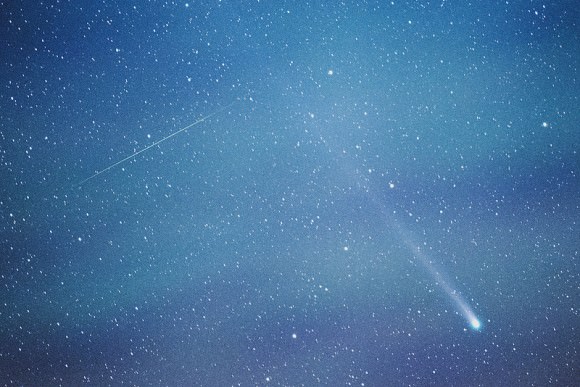
Though the Geminids appear to radiate from the constellation Gemini, they can appear anywhere in the sky. Tracing the path back can determine the source constellation and the “membership” of a given meteor. Random meteors not associated with any identified shower are known as “sporadics.” Block that pesky light-polluting Moon behind a building or hill to optimize your chances of catching sight of a meteor. Employing a friend or two to watch in different directions will also maximize the number seen. The International Meteor Organization always welcomes reports from observers… this is real science that you can contribute to using nothing more sophisticated than your eyes!
The Geminids are medium-speed meteors with an average atmospheric velocity of about 35 kilometres per second, often leaving long, glowing trails worth examining with a pair of binoculars. You might note an apparent surge in speed to this shower past local midnight, as your vantage point turns into the oncoming shower, adding the velocity of the Earth to the approaching Geminids.
Photographing meteors is fun and easy to do; all you’ll need is a DSLR camera mounted on a tripod. Take several manual setting exposures to get the combination of ISO,F-stop, and shutter speed correct for your local sky conditions. Then simply set the focus to infinity, and use the widest field of view possible. Catching meteors is surreptitious, as they can appear anywhere – and at any time – in the sky. Be sure to thoroughly review those images afterwards… nearly every meteor we’ve caught photographically went unnoticed during observation!
Also, remember that cold weather plus long exposure times can conspire to drain camera batteries in a hurry. Be sure to keep a spare set of charged batteries ready to go in a warm pocket!
How powerful will the Geminids become? Are we in for a “return of the Andromedids” moving towards 2014? One thing is for sure: you won’t see any meteors if you don’t try. So be sure to get out there, pour a mug of your favorite warming beverage, and don’t miss the 2013 Geminid meteor shower!
– Got meteors? Be sure and tweet ‘em to #Meteorwatch.
– Be sure to send those pics of Geminids and more in to Universe Today.

